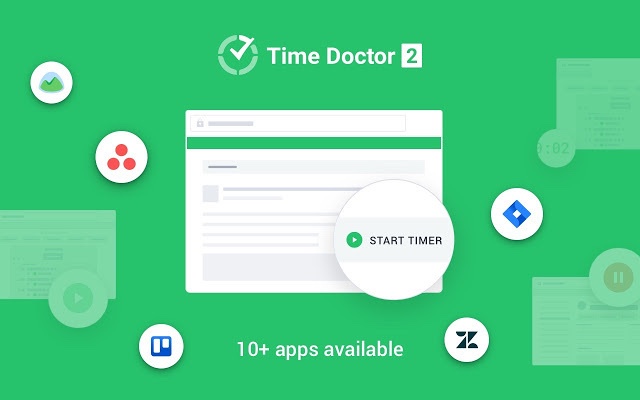An employee with excellent time management skills can predict accurate deadlines, complete tasks on time, and maintain high reliability.
But how does an employee develop this skill?
One way is by conducting time management training for employees.
This involves teaching employees how to identify goals, encouraging the use of time tracking tools, and more.
In this article, we’ll discuss everything you need to know about time management training for employees, including its 11 best practices and three strategies. We’ll also look into its three advantages and two challenges.
This Article Includes:
(Click on the link to go to a particular section)
- 11 proven tips for successful time management training for employees
- 3 effective employee time management training strategies
- 3 key benefits of time management training for employees
- 2 challenges of time management training for employees
Let’s get started.
11 proven tips for successful time management training for employees
Time management training is essential for meeting deadlines, disciplined workflow, and maximum productivity. It can be conducted by managers with effective time management skills or an expert, depending on talent accessibility and budget.
If you decide to conduct the management course yourself, here are the 11 best practices of time management training for employees:
1. Teach goal identification
Goal setting can help employees identify what’s expected from them.
Teach your employees to select SMART (Specific, Measurable, Achievable, Relevant, Time-bound) goals instead of overwhelming and unrealistic ones.
SMART goals can help your employees manage tasks and complete them in less time.
You can also ask them to set goals that guide them to achieve the main SMART goal.
For example, if the SMART goal is completing a project in three weeks, the mini goals can be creating a checklist, recruiting a team, assigning tasks, and setting deadlines.
2. Remind employees to create a to-do list
A to-do list is the collection of all the tasks an employee has to complete in a workday to achieve the goals.
Here are a few benefits of creating a to-do list:
- Mentally prepares employees for the tasks and helps them be more productive.
- Shows the timeline of tasks they need to finish.
- Helps them complete their tasks efficiently.
- Ensures they don’t leave out any task.
That’s why you can encourage your employees to write down the tasks in the morning or the night before.
3. Ask to complete the most important task first
Sometimes, employees may take up the wrong tasks to work on in the morning and end up submitting important tasks late.
To avoid this, you need to guide them with prioritizing tasks based on deadlines and order of importance. An employee needs to work through the most to least important tasks for effective time management.
To implement this easily, you can try techniques like marking urgent tasks, setting deadline alerts, etc. These strategies can give employees an idea of which tasks need immediate attention.
4. Encourage time tracking
Time tracking is essential to know how much time an employee spends on a specific task. They can compare the time they take with that of their colleagues and analyze their own performance.
This way, employees can find their shortcomings and work on improving themselves.
Additionally, employers may be able to spot time-consuming and unnecessary activities in their schedule and take steps to avoid them.
For example, let’s say a remote employee notices that their lunch break takes longer than required. They can then set an alarm not to exceed the planned break time.
Fortunately, time tracking tools like Time Doctor can help you with logging hours.
What is Time Doctor?

Time Doctor is a powerful employee time tracking and productivity management tool that’s used by small businesses, like Thrive Market, as well as large enterprises, like Ericsson.
The tool offers an interactive time tracker which lets employees record the time they take to complete specific tasks. They can just start and stop the timer as they begin and end their task.
The tool also has an idle time tracker that detects inactivity and tracks how long the employee isn’t working. After a certain period, the tool will automatically show a pop-up, nudging the employee to focus on their tasks.
Check out the other handy Time Doctor features.
5. Allow employees to delegate less important tasks
Delegating tasks can save employees valuable time and let them work on other important tasks. This way, they may not have to put in more hours to complete important tasks, preventing burnout.
This is especially applicable to employees in leadership positions who have to manage several projects and other operational tasks.
In addition to giving such employees more time, delegating can also prompt other team members to learn more management skills.
For example, an employee can delegate making an attendance spreadsheet for a project to an intern. Not only will this clear some space in their daily schedule, but it also allows the intern to learn the ropes.
6. Encourage taking short breaks
According to a 2019 study, breaks are crucial for employee recovery during a demanding day. It also reports that taking breaks helps employees with performance management, mental and physical health maintenance, and workspace safety.
For effective time management involving breaks, you can guide an employee to effectively incorporate break times between work hours.
For example, they can work hard for 30 minutes and take a 5-minute break after that.
This way, they may not feel mentally exhausted during work. And can do their best while working.
7. Spot most productive times
An employee may be the most productive at a particular time of the workday.
By identifying these, they can schedule important tasks during their productive times and manage performance.
For example, morning people can schedule tasks that require more time during the early hours. This way, they may complete the tasks quickly due to their peak productivity with less stress.
And they can work through the smaller tasks after lunch when they’re not at their productive best.
Similarly, you can schedule team decision-making meetings during specific times when employees are energetic.
How can an employee identify their productive times?
Tools like Time Doctor generates detailed productivity reports that give you in-depth insights into an employee’s productivity. Based on these reports, you can ask employees to plan their task list.
8. Motivate employees to manage stress
No matter how dedicated an employee is to following their to-do list, an unforeseen interruption could put them off track.
Such situations could stress out some employees, ultimately affecting their time management and productivity.
That’s why you need to train your employees to build a positive attitude towards interruptions and help them manage stress. It’ll help them replan their schedule instead of stressing out during such situations.
9. Provide tips to stay focused
Everything from social media to chatty colleagues can keep an employee from focusing on their daily tasks.
To avoid this, your training should include tips to avoid distractions, such as:
- Switch off mobile phones or mute notifications.
- Find a comfortable workspace away from the crowd.
- Clear the mind before working to ensure complete focus.
- Avoid multitasking as it can prevent employees from concentrating on one task.
However, distractions can’t be eliminated completely. As a result, your employees need to retain their productivity during unfavorable work situations.
To achieve that, you can conduct attention management training and help them understand how to manage distractions and be productive.
10. Let employees use technology to automate tasks
Employees can leverage features like time tracking and payroll generation to cut down the number of tasks with the latest tools. This way, they may get enough time to concentrate on tasks that need their attention and handle multiple projects efficiently.
For example, you can provide HR tools like Zoho Cloud or Breezy HR to a human resource person to help them manage payroll, employee data, and more.
Similarly, you can provide a project management tool like Asana and Monday.com to your development team to help them track multiple project deadlines, team performance, etc.
But you need to ensure that all your tools integrate with each other to avoid management difficulties or juggling between tools.
For instance, Time Doctor offers a Chrome extension that integrates with over 40 premium business tools.
Let’s look at a few of them:
- Project management: Azure DevOps, ClickUp, Evernote, etc.
- Payment and invoicing: FreshBooks, PayPal, Wise.
- Helpdesk: Freshdesk, Zendesk, etc.
This way, you can track the time each employee spends on various workplace tools with ease.
11. Lead by example
Employees look up to you to learn effective time management skills.
So you need to display the time management qualities you want to develop in them.
For example, you need to be present for meetings and log in to work on time. Similarly, practice informing about absences or late arrivals as soon as possible to enable other employees to plan their time better.
Support your employees to practice similar techniques to excel at time management and assist their colleagues.
Additionally, you can improve your time management techniques by looking for quality time management skills in other managers and employees.
Now, let’s explore the different time management training strategies.
3 effective employee time management training strategies
You need to choose the right time management training strategy to guarantee that the training program will be effective.
Let’s look at the different employee time management training strategies:
1. Group activities
You can carry out time management training via employee gatherings, like webinars, seminars, workshops, or other team events.
In addition to inculcating time management skills, group activities can also help build relationships between colleagues. This, in turn, can lead to better teamwork and higher employee productivity.
2. On-the-job training
In this type of time management strategy, you can conduct training while employees are working. Identify and observe the issue an employee faces while they work and help them overcome it.
For instance, let’s say you notice an employee is distracted easily during their task. You can share attention management tips to help them.
The training sessions can either be headed by you or a time management professional. If you decide to conduct the training, it could be a great opportunity to connect with your team members.
3. Online courses
Online training is a viable option for employees with busy schedules. They can attend the time management training course anytime during the week.
To encourage an employee to attend it, you can offer incentives or other benefits. For example, you can give a free movie ticket to an employee who attends the training on time.
Now, let’s look at the benefits of time management training.

3 key benefits of time management training for employees
Clearly, time management training requires your and your employees’ effort and time.
By explaining the pros of taking the training to your employee, you can motivate them to attend it genuinely — rather than under pressure.
Let’s look at the importance of time management training:
1. Better work life balance
Good time management enables an employee to constrain their work during office hours and spend the rest of their day engaging in other activities.
For example, an employee with effective time management skills may complete all tasks on their to-do list on time and hit the gym later.
Similarly, a customer service employee may attain their SMART goal by the end of the working day. This may give them more time to spend with their family and friends.
2. Less procrastination
An employee may not be able to complete their tasks on time due to a distraction, leading to poor time management and procrastination.
Time management training gives employees more control over their workload and ensures they complete their work on time.
For example, an employee who mutes their phone notifications may be able to complete a task quicker than another employee who attends all phone calls they receive. Consequently, the second employee may have to procrastinate and ultimately stress out about the pile of tasks.
3. Improves career opportunities
Since time management training can empower an employee to wrap up projects on time, they may be deemed reliable and dedicated. This can create a positive impression among employers and help with their professional development.
For example, an employee may complete a project with tight deadlines on time with good time management skills. This can increase their chances of promotion, bonuses, etc.
Moreover, employees may understand the company values them, increasing employee engagement.
Let’s now look at the challenges of time management training.
2 challenges of time management training for employees
Let’s look at two common issues you may face during time management training and how to overcome them:
1. Requires time and effort
Time management training may require learners to put extra effort and time into work.
For example, an employee may have to attend an online time management course during the weekend.
If you conduct training during work hours, they may find it difficult to manage work and training.
To overcome this, you can schedule time management training classes when employees are feeling unproductive. Additionally, keep these classes short to prevent exhaustion.
2. Needs investment
Hiring a professional time management trainer can cost a huge amount of money due to the frequency of training. The trainer may have to come in once every week or month, depending on your requirements.
Moreover, if you’re hiring from a distant location, you may have to provide the trainer with accommodation and other facilities.
Instead, your company can enroll a few managers or senior employees in time management training. After completing the course, they can teach other employees to manage time. This way, the company will only have to spend money on a few training classes.
Certainly, the benefits of time management training outweigh its disadvantages. Moreover, you can incorporate great time management training into your company with careful planning.
Wrapping up
Managers should educate employees on time management techniques to foster employee satisfaction, prevent stress, and boost productivity.
You can go through the best practices and strategies mentioned in the article to develop effective time management training sessions.
Additionally, look into the benefits and challenges mentioned above for a better understanding of conducting time management training.

Vaishali Badgujar is a Content and SEO specialist at Time Doctor, an employee-friendly time-tracking system that boosts productivity.


